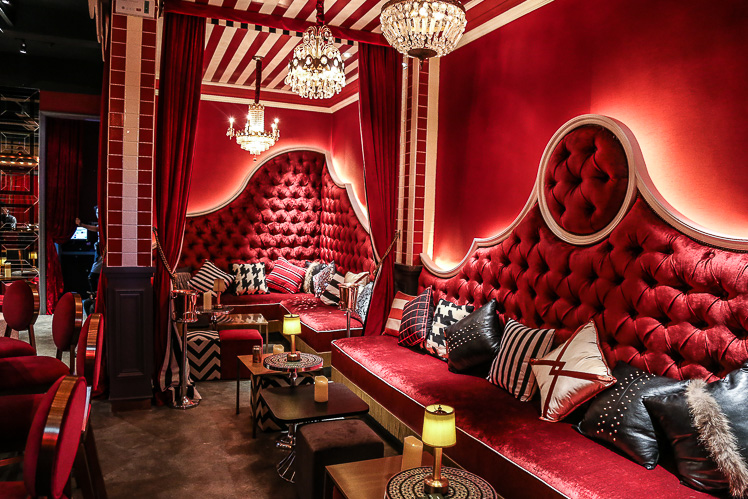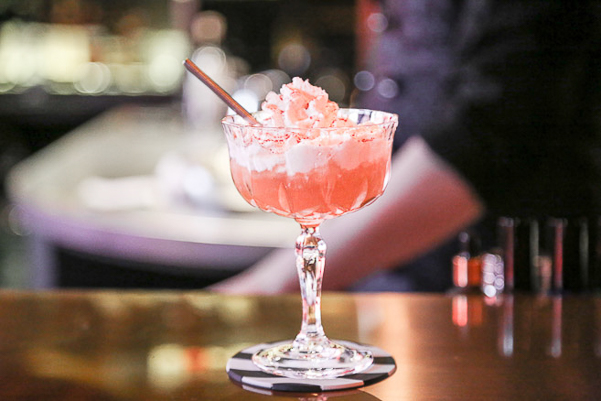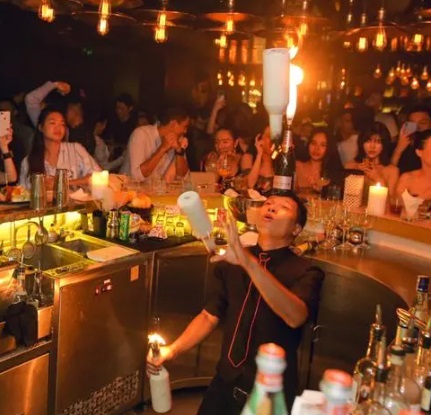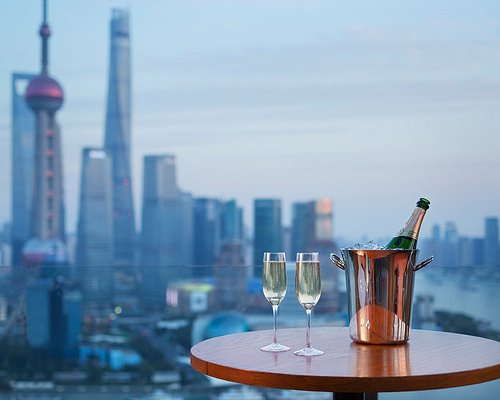In recent years, China has seen a remarkable surge in the popularity of luxury bars, marking a significant shift in the country’s nightlife and leisure industry. These upscale establishments are not just about serving high-end drinks; they represent a fusion of sophisticated ambiance, cultural elegance, and a testament to the evolving tastes of China’s affluent consumers.
One striking example of this trend is the “Jade on 36 Bar” located in the Pudong Shangri-La, Shanghai. Perched on the 36th floor, this bar offers breathtaking views of the Shanghai skyline, setting the stage for an unforgettable experience. The interior design is a blend of modern chic and traditional Chinese elements, creating a luxurious yet culturally rich atmosphere. Patrons can indulge in an array of meticulously crafted cocktails and a selection of fine wines and spirits, each telling its story of heritage and craftsmanship.

Another notable mention is “Beijing’s Xian Bar,” situated in the East Hotel. This bar has become a symbol of luxury and trendsetting in Beijing’s nightlife. Xian Bar’s design seamlessly combines rustic elements with contemporary style, featuring live music performances that add to its vibrant and sophisticated character. It’s not just a bar; it’s a destination for the city’s elite and discerning travelers, offering a unique blend of luxury, entertainment, and cultural immersion.
Candor’s pièce de résistance, the Ramos Gin Fizz, which takes 20-30 minutes to make
LifeStyle on Social Media in China
These luxury bars are more than just drinking spots; they are social landmarks where the affluent come to network, celebrate, and relax in style. They cater to a clientele that appreciates the finer things in life, from the quality of the beverages to the ambiance and service. As China’s luxury market continues to grow, these bars set a new standard in hospitality, reflecting the country’s deepening relationship with luxury and its continuous innovation in delivering exclusive experiences.

Candor’s pièce de résistance, the Ramos Gin Fizz, which takes 20-30 minutes to make
The Hill Food & Drink in Beijing
Haidilao, a prominent Chinese hot pot brand, has recently ventured into a new domain with the opening of a high-end Chinese-style bistro in Beijing, named “The Hill Food & Drink.” Targeting upscale diners, the establishment boasts an average price of 304 RMB (approximately 42.92 USD) per person, offering a culinary experience centered around Southwest China’s flavors, particularly from Yunnan, Guizhou, and Sichuan regions, with a special focus on charcoal-grilled and roasted dishes, along with fermented specialties.
The bistro features a unique dual setting, with a café on the ground floor and a bar upstairs, embodying the popular Chinese concept of “morning C (coffee) evening A (alcohol)”
This concept, originally derived from a skincare routine, has become a lifestyle emblem among young, urban professionals, symbolizing a balance of work and leisure.
The interior of The Hill resonates with an artistic ambiance, blending raw walls and metallic furnishings in what is described as a “wasteland” or “industrial” style, yet infused with Southwest China elements like a cozy patio with a decorative firepit. This setup offers an engaging dining and drinking experience, aligning with the tastes of young professionals seeking novel experiences.
Bistros, known in Chinese as “小酒馆”, particularly those serving Chinese cuisine, have seen a surge in popularity as trendy spots for casual fine dining and socializing.
On littleRedbook, a popular social media platform, mentions of bistros have nearly doubled in the last year, jumping from about 180,000 to over 350,000. Their appeal lies in their relaxed yet sophisticated atmosphere, diverse culinary offerings, and a variety of drink options, making them ideal for both romantic outings and casual relaxation.
Haidilao’s foray into bistros isn’t new. Since 2021, the company has integrated “bistro” corners within their hot pot restaurants, offering cocktails and liquors. This move parallels other industry trends, such as Nayuki’s now-closed BlaBlaBar and Starbucks’ Bar Mixato in Shanghai.
Additionally, Haidilao has launched a new sub-brand, Hailao Huoguo (hot pot), with a more affordable pricing model at 78 RMB (11.01 USD) per person. This brand shift is part of Haidilao’s strategy to cater to a “K-shaped” consumer segmentation, acknowledging the growing divide where consumers are increasingly gravitating either towards budget-friendly options or high-end luxury, moving away from the middle ground of “accessible luxury.”
Little Red book and Lifestile
- Platform for Lifestyle and Fashion Trends: Little Red Book (Xiaohongshu) is a popular social media platform in China, renowned for its focus on lifestyle, beauty, and fashion trends. It serves as a go-to source for users seeking inspiration and advice on various aspects of contemporary living, from the latest fashion styles to home décor and wellness.
- User-Generated Content and Community Engagement: The platform thrives on user-generated content, with millions of users sharing their personal experiences, product reviews, and lifestyle tips. This fosters a community-driven environment where users actively engage with each other, offering recommendations and feedback.
- Influencer and KOL Hub: Little Red Book is a key platform for Key Opinion Leaders (KOLs) and influencers in China. These influencers play a crucial role in shaping lifestyle trends and consumer choices, often influencing purchasing decisions through their posts and endorsements.
- Integration with E-commerce: The platform seamlessly integrates social media with e-commerce, enabling users to purchase products directly through the app. This integration has made it an influential player in online shopping, particularly for beauty and fashion products.
- Window to Global Trends: Little Red Book connects Chinese consumers with global lifestyle trends. Users often share experiences and reviews of international brands and products, making it a vital bridge between Chinese consumers and the wider global market in terms of fashion and lifestyle choices.
This expansion and diversification reflect Haidilao’s adaptability and innovation in the evolving hospitality landscape post-pandemic.
Haidilao:
- Leading Hot Pot Chain: Haidilao is renowned for its hot pot restaurants, known for their quality ingredients and exceptional service.
- Global Presence: The brand has expanded internationally, with restaurants in various countries, showcasing the global appeal of its hot pot cuisine.
- Innovative Service Model: Haidilao is famous for its customer-centric service, including unique offerings like noodle dances and manicures while you wait.
- Diverse Menu Options: The menu caters to a wide range of tastes, offering various broths and a plethora of ingredients suitable for diverse palates.
- Technological Integration: The brand integrates technology in its operations, from digital ordering systems to robotic servers in some locations.
- Expansion into Diverse Concepts: Haidilao has ventured into different dining concepts, including bistros and more affordable hot pot options.
- Focus on Quality and Hygiene: The chain is noted for maintaining high standards of food quality and hygiene in all its outlets.
- Customization and Personalization: It offers personalized experiences with customizable hot pot ingredients and flavors.
- Strong Brand Recognition: Haidilao is a well-known name in the hot pot industry, synonymous with quality and a high-end dining experience.
- Adapting to Market Trends: The brand is responsive to market trends and consumer preferences, continually evolving its offerings and dining concepts.
The Bar Market in China:

- Rapid Growth: The bar market in China has seen substantial growth, especially in major cities like Beijing, Shanghai, and Guangzhou.
- Diverse Offerings: Bars in China offer a wide range of experiences, from high-end cocktail bars to casual pubs and themed establishments.
- Cultural Integration: Many bars incorporate traditional Chinese elements in their décor and menu, blending Eastern and Western influences.
- Young Consumer Base: The bar scene is particularly popular among young professionals and millennials, who are attracted to the social aspect of bar culture.
- Craft Beer Trend: There has been a rise in craft beer popularity, with numerous microbreweries and craft beer bars opening across the country.
- Cocktail Innovation: Chinese bars are known for their innovative cocktails, often using unique ingredients and presentation styles.
- Nightlife as Social Hub: Bars serve as important social hubs in urban areas, catering to a clientele looking for relaxation and networking opportunities.
- Increasing International Influence: The influence of international trends and bartenders has led to a more sophisticated bar scene in China.
- Events and Entertainment: Many bars host regular events, live music, and themed nights to attract customers and create a vibrant atmosphere.
- Regulatory Environment: The bar market operates within a regulatory framework that varies by region, impacting operating hours and alcohol service.
Read more

